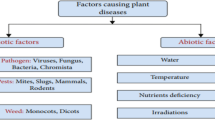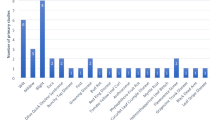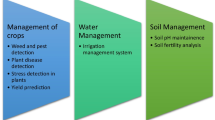Abstract
Farming has a plethora of difficult responsibilities, and plant monitoring is one of them. There is also an urgent need to increase the number of alternative techniques for detecting plant diseases, which is now lacking. The agriculture and agricultural support sectors in India provide employment for the great majority of the country’s people. In India, the agricultural production of the country is directly connected to the country’s economic growth rate. In order to sustain healthy plant development, a variety of processes must be followed, including consideration of environmental factors and water supply management for the optimal production of crops. It is inefficient and uncertain in its outcomes to use the traditional method of watering a lawn. The devastation of more than 18% of the world’s agricultural produce is caused by disease attacks on an annual basis. Because it is difficult to execute these activities manually, identifying plant diseases is essential to decreasing losses in the agricultural product business. In addition to diagnosing a wide range of plant ailments, our method also includes the identification of infections as a prophylactic step. Below is a detailed description of a farm-based module that includes numerous cloud data centers and data conversion devices for accurately monitoring and managing farm information and environmental elements. This procedure involves imaging the plant’s visually obvious signs in order to identify disease. It is recommended that the therapy be used in conjunction with an application to minimize any harm. Increased productivity as a result of the suggested approach would help both the agricultural and irrigation sectors. The plant area module is fitted with a mobile camera that captures images of all of the plants in the area, and all of the plants’ information is saved in a database, which is accessible from any computer with Internet access. It is planned to record information on the plant’s name, the type of illness that has been afflicted, and an image of the plant. In a wide range of applications, bots are used to collect images of various plants as well as to prevent disease transmission. To ensure that all information given is retained on the Internet, data is collected and stored in cloud storage as it becomes essential to regulate the condition. According to our findings from our research on wide images of healthy and ill fruit and plant leaves, real-time diagnosis of plant leaf diseases may be done with 98.78% accuracy in a laboratory environment. We utilized 40,000 photographs and then analyzed 10,000 photos to construct a DCDM deep learning model, which was then used to train additional models on the data set. Using a cloud-based image diagnostic and classification service, consumers may receive information about their condition in less than a second on average, with the process requiring only 0.349 s on average.













Similar content being viewed by others
References
Akram, T., Naqvi, S. R., Haider, S. A., & Kamran, M. (2017). Towards real-time crops surveillance for disease classification: Exploiting parallelism in computer vision. Computers & Electrical Engineering, 59, 15–26.
Chad, D., Tyr, W. H., Chen, S., et al. (2017). Automated identification of northern leaf blight-infected maize plants from field imagery using deep learning. Phytopathology, 107, 1426–1432.
Chohan, M., Khan, A., Chohan, R., Katpar, S. H., & Mahar, M. S. (2020). Plant disease detection using deep learning. International Journal of Recent Technology and Engineering, 9(1), 909–914.
Chopda, J., Raveshiya, H., Nakum, S., & Nakrani, V. (2018). Cotton crop disease detection using Decision Tree Classifier. 2018 International Conference on Smart City and Emerging Technology (ICSCET) (pp. 1–5). IEEE.
Coulibaly, S., Kamsu-Foguem, B., Kamissoko, D., & Traore, D. (2019). Deep neural networks with transfer learning in millet crop images. Computers in Industry, 108, 115–120.
da Silva Abade, A., de Almeida, A. P. G., & de Barros Vidal, F. (2019). Plant diseases recognition from digital images using multichannel convolutional neural networks. VISIGRAPP.
de Luna, R. G., Dadios, E. P., & Bandala, A. A. (2018). Automated image capturing system for deep learning-based tomato plant leaf disease detection and recognition. TENCON 2018–2018 IEEE Region 10 Conference (pp. 1414–1419). IEEE.
Dhiraj, Biswas, R., & Ghattamaraju, N. (2019). An effective analysis of deep learning-based approaches for audio-based feature extraction and its visualization. Multimedia Tools and Applications, 78(17), 23949–23972.
Ferentinos, K. P. (2018). Deep learning models for plant disease detection and diagnosis. Computers and Electronics in Agriculture, 145, 311–318.
Hu, M., Bu, X., Sun, X., Yu, Z., & Zheng, Y. (2017). Rape plant disease recognition method of multi-feature fusion based on D-S evidence theory. Mathematical and Computational Applications, 22(1), 18.
Iqbal, Z., Khan, M. A., Sharif, M., Shah, J. H., ur Rehman, M. H., & Javed, K. (2018). An automated detection and classification of citrus plant diseases using image processing techniques: a review. Computers and Electronics in Agriculture, 153, 12–32.
Kao, I. -H., Hsu, Y. -W., Yang, Y. -Z., Chen, Y. -L., Lai, Y. -H., & Perng, J. -W. (2019). Determination of Lycopersicon maturity using convolutional autoencoders. Scientia Horticulturae, 256, 108538.
Khamparia, A., Saini, G., Gupta, D., Khanna, A., Tiwari, S., & de Albuquerque, V. H. C. (2020). Seasonal crops disease prediction and classification using deep convolutional encoder network. Circuits, Systems, and Signal Processing, 39(2), 818–836.
Li, D., Deng, L., Lee, M., & Wang, H. (2019). IoT data feature extraction and intrusion detection system for smart cities based on deep migration learning. International Journal of Information Management, 49, 533–545.
Lu, Y., Yi, S., Zeng, N., Liu, Y., & Zhang, Y. (2017). Identification of rice diseases using deep convolutional neural networks. Neurocomputing, 267, 378–384.
Mangalraj, P., Sivakumar, V., Karthick, S., Haribaabu, V., Ramraj, S., & Samuel, D. J. (2019). A review of multi-resolution analysis (MRA) and multi-geometric analysis (MGA) tools used in the fusion of remote sensing images. Circuits, Systems, and Signal Processing, 39(6), 3145–3172.
Marko, A., Mirjana, K., Srdjan, S., Andras, A., & Darko, S. (2019). Solving current limitations of deep learning-based approaches for plant disease detection. Symmetry-Baseline, 11(7), 939.
Meziani, A., Djouani, K., Medkour, T., & Chibani, A. (2019). A Lasso quantile periodogram based feature extraction for EEG-based motor imagery. Journal of Neuroscience Methods, 328, 108434.
Mohameth, F., Bingcai, C., & Sada, K. A. (2020). Plant disease detection with deep learning and feature extraction using plant village. Journal of Computer and Communications, 8(6), 10–22.
Mohanty, S. P., Hughes, D. P., & Salathé, M. (2016). Using deep learning for image-based plant disease detection. Frontiers in Plant Science, 7, 1419.
Ni, C., Wang, D., Vinson, R., Holmes, M., & Tao, Y. (2019). Automatic inspection machine for maize kernels based on deep convolutional neural networks. Biosystems Engineering, 178, 131–144.
Patil, J. K., & Kumar, R. (2016). Analysis of content-based image retrieval for plant leaf diseases using color, shape and texture features. Engineering in Agriculture, Environment and Food, 10, 69–78.
Pertot, I., Kuflik, T., Gordon, I., Freeman, S., & Elad, Y. (2012). Identification: A web-based tool for visual plant disease identification, a proof of concept with a case study on strawberry. Computers and Electronics in Agriculture, 84, 144–154.
Pujari, D., Yakkundimath, R., & Byadgi, A. S. (2013). Grading and classification of anthracnose fungal disease of fruits based on statistical texture features. International Journal of Advanced Science and Technology, 52, 121–132.
Raza, M., Sharif, M., Yasmin, M., Khan, M. A., Saba, T., & Fernandes, S. L. (2018). Appearance-based pedestrians’ gender recognition by employing stacked autoencoders in deep learning. Future Generation Computer Systems, 88, 28–39.
Sanga, S. L., Machuve, D., & Jomanga, K. (2020, June). Mobile-based deep learning models for banana disease detection. Engineering, Technology & Applied Scientific Research, 10(3), 5674–5677.
Tiwari, D., Ashish, M., Gangwar, N., Sharma, A., Patel, S., & Bhardwaj, S. (2020, May). Potato leaf disease detection using deep learning. In 2020 4th International Conference on Intelligent Computing and Control Systems (ICICCS) (pp. 461–466). IEEE.
Vasan, D., et al. (2020). IMCFN: Image-based malware classification using fine-tuned convolutional neural network architecture. Computer Networks, 171, 107138.
Xu, C., Chai, Y., Li, H., Shi, Z., Zhang, L., & Liang, Z. (2019a). A feature extraction method for the wear of milling tools based on the Hilbert marginal spectrum. Machining Science and Technology, 23, 847–868.
Xu, Y., Ding, H., Xue, Y., & Guan, J. (2019b). High-dimensional feature extraction of sea clutter and target signal for intelligent maritime monitoring network. Computer Communications, 147, 76–84.
Yang, N., Qian, Y., El-Misery, H. S., Zhang, R., Wang, A., & Tang, J. (2019). Rapid detection of rice disease using microscopy image identification based on the synergistic judgment of texture and shape features and decision tree-confusion matrix method. Journal of the Science of Food and Agriculture, 99(14), 6589–6600.
Zhang, S., You, Z., & Wu, X. (2019a). Plant disease leaf image segmentation based on superpixel clustering and EM algorithm. Neural Computing and Applications, 31(S2), 1225–1232.
Zhang, X., Qiao, Y., Meng, F., Fan, C., & Zhang, M. (2018). Identification of maize leaf diseases using improved deep convolutional neural networks. IEEE Access, 6, 30370–30377.
Zhang, Y., Wei, X. -S., Wu, J., et al. (2016). Weakly supervised fine-grained categorization with part-based image representation. IEEE Transactions on Image Processing, 25(4), 1713–1725.
Zhang, Z., Liu, H., Meng, Z., & Chen, J. (2019b). Deep learning-based automatic recognition network of agricultural machinery images. Computers and Electronics in Agriculture, 166, 104978.
Author information
Authors and Affiliations
Corresponding author
Ethics declarations
Conflict of interest
The authors declare no competing interests.
Additional information
Publisher's Note
Springer Nature remains neutral with regard to jurisdictional claims in published maps and institutional affiliations.
Rights and permissions
Springer Nature or its licensor holds exclusive rights to this article under a publishing agreement with the author(s) or other rightsholder(s); author self-archiving of the accepted manuscript version of this article is solely governed by the terms of such publishing agreement and applicable law.
About this article
Cite this article
Kumar, P., Raghavendran, S., Silambarasan, K. et al. Mobile application using DCDM and cloud-based automatic plant disease detection. Environ Monit Assess 195, 44 (2023). https://doi.org/10.1007/s10661-022-10561-3
Received:
Accepted:
Published:
DOI: https://doi.org/10.1007/s10661-022-10561-3




